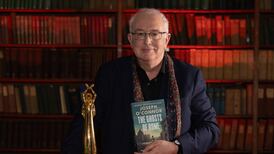It was the former Kerry secretary, Tony O’Keeffe, who made the point back in 2000 after the drawn All-Ireland with Galway. His county, he said, was never far away in ‘big years’.
He was talking about the Millennium and Kerry duly won Sam Maguire after the replay, a couple of weeks later. They added the peripheral distinction of becoming the first county to win the All-Ireland on a Saturday. O’Keeffe also reeled off other landmarks:
The Centenary year in 1984 (beat Dublin); the first 80-minute final in 1970 (beat Meath) and five years later, when match duration was reduced to 70 minutes (beat Dublin); when the second Hogan Stand was opened in 1959 (beat Galway); when the Cusack Stand was unveiled in 1938 (drew with Galway, lost replay). And so on.
Mind you, this can overlook other important years like the first championship played through the qualifiers in 2001. But still, perhaps it shouldn’t have been a surprise when Kerry made off with the first championship to be played under the Football Review Committee (FRC) ‘enhanced’ rules.
READ MORE
Picking through the entrails of the final, it is easy to understand how a new set of playing rules, intended to declutter forward play and reward long-range shooting, benefited the team with the greater number of outstanding individuals.
Set against the strength of Donegal’s collective for a much anticipated final, the contest quickly turned into a tactics tutorial where the Ulster champions were the ones taking notes.
The FRC rule changes were well mastered by Kerry. The new space up front with the 4v3 requirement created more room for their attacks, and the deployment of forwards cleverly added to that by at times pulling David Clifford’s marker Brendan McCole away from the middle and using the width of the field.
It was reminiscent of Dublin’s unpicking of the blanket defence by stretching it across the field, most devastatingly against Tyrone in the 2017 All-Ireland semi-final, with the intention of creating one-on-ones.

It also posed questions about the viability of zonal defence in the age of the FRC, a vulnerability outlined in advance with penetrating clarity by Éamonn Fitzmaurice in Saturday’s Irish Examiner.
Maybe the signs were already there during the league, which Kerry finished as top goal scorers. In those days, Jack O’Connor used to be badgered as to why his team scored so few two-pointers. As long as we win, I don’t mind, was his essential answer.
[ How Kerry pulled off tactical masterclass to beat Donegal in All-Ireland finalOpens in new window ]
On Sunday he was asked about the team’s by now prolific embrace of the two-pointers – they scored five on Sunday. He replied that they had done a lot of work on the scores at their pre-championship camp.
Conor McManus’s point in his Irish Times column also bears repetition. You have the best footballers, on the best surface, at the best time of the year, optimising the chances for kicking scores from 40 metres.
At the end of the regulation league campaign in Galway last March, O’Connor was asked whether the rules suited Kerry.
“I think so,” he replied. “Sure, it’s very exciting. You can see from the scores that have been racked up. What did we finish? 3-21? 3-24? That’s a hurling score. We’ve put up a lot of big scores – 5-15 above in Derry.”
The move towards contested kick-outs has also been key for Kerry. In the absence of Diarmuid O’Connor, who made a late appearance in the final, and Barry Dan O’Sullivan, their centrefield looked under pressure. But the brilliant cultivation of two panellists, Mark O’Shea and Seán O’Brien, who worked hard and were athletic and competitive under high ball, meant that any long kick-outs were well contested.
It also allowed Joe O’Connor to switch between the wing and the middle – and his performances were a revelation. All told – allowing that they were facilitated by Ciarán Thompson’s early injury – that force field in the middle third, combined with energy and anticipation on breaking ball, overwhelmed what had been a decent Donegal set-up, at least until Jason McGee’s arrival.

There was another factor involved and that was experience of All-Ireland finals. The previous week, Tipperary had eight hurlers who had won medals; Cork had none. This weekend, it was Kerry, who had 10 starters who had played in the 2022 victory, whereas Donegal had one with a Celtic Cross from 2012, plus another on the bench.
Before the 2013 final Kerry elder statesman John O’Keeffe, then this newspaper’s football analyst, made an interesting point about Jim Gavin’s youngest players – Jack McCaffrey, Paul Mannion and Ciarán Kilkenny – who had all been minors two years previously.
Referring to his own experience as a teenager involved in All-Irelands, he cautioned: “I just feel that fellas who have been there before tend to do the right thing at the right time.”
Previewing the final, O’Keeffe said of the young footballers: “Tomorrow requires an even greater leap. To have gone through it before is of enormous value. To have not, makes a younger player’s performance almost a lottery.”
The three were replaced during the final by the three-quarter hour mark, although Mannion’s substitution was caused by injury.
[ Joe O’Connor’s talent comes through after early injury setbacks in Kerry careerOpens in new window ]
Finally, the choreography around Jack O’Connor’s future as Kerry manager is reminiscent of former president of Ireland, Paddy Hillery. A year out from the 1983 election and with jockeying for position all around, Hillery had the look of a one-term president. After all, he had not been elected in the first place but obligingly made himself available as a consensus candidate in 1976 after Cearbhall Ó Dálaigh (for added topicality, buried in Sneem) had been insulted into resignation by defence minister Patrick Donegan.
Irish Times political columnist and seer John Healy, however, stirred puzzlement earlier in the year by stating that not alone would Paddy Hillery be the next president but that he would have all parties begging him to do it. And so it proved.
















